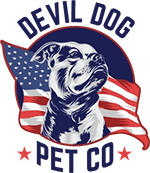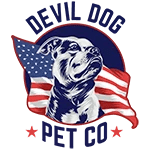The Doggo Revolution: Why Internet Slang Matters for Real Training
The first time a customer walked into our training area and announced they had a "heckin' good doggo," I nearly dropped my clicker. As a Marine veteran, I was trained to communicate with brutal precision—no fluff, no nonsense. But here was this proud owner, smartphone in hand, speaking what sounded like a foreign language about their perfectly normal Labrador.
That was 2017, and I quickly realized this wasn't just one quirky owner. Internet dog culture had officially infiltrated real-world training, and terms like "doggo," "pupper," and "bork" were suddenly everywhere. Our dog Dexter even had his own Instagram followers who called him a "handsome doggo" despite him being blissfully unaware of his online fame.
But here's what fascinated me: behind this seemingly silly internet slang was something deeper—a genuine revolution in how Americans connect with their dogs. The doggo phenomenon isn't just cute internet speak; it represents a fundamental shift in the human-canine relationship that directly impacts training success.
What the Heck is a Doggo, Anyway?

Before we dive into training commands, let's define doggo. The term emerged from internet culture around 2016 as an affectionate slang word for dogs of any size or breed. It's part of a larger internet language called "DoggoLingo" that includes terms like "blep" (tongue slightly out), "mlem" (licking), and the distinction between "puppers" (small dogs) and "woofers" (big dogs).
This isn't just random internet nonsense. Linguists have studied doggo-speak extensively, noting how it creates emotional connection through deliberately childlike vocabulary. When someone calls their German Shepherd a "big scary doggo doing a protect," they're using language that creates both humor and affection—two critical components of successful training.
The Psychology Behind Doggo-Speak
The psychology behind why we use doggo slang matters for training. When owners use terms like "good doggo" during training sessions, they typically use a higher pitch and more animated expressions—exactly what dogs respond to. The exaggerated, playful nature of doggo-speak mirrors the "motherese" humans naturally use with babies, creating stronger emotional bonds.
This matters because emotional connection drives training success. A 2018 study found that dogs whose owners regularly used high-pitched, emotional praise showed significantly better recall response than those whose owners used flat, monotone commands. The doggo revolution isn't just cute—it's accidentally effective.
7 Essential Commands Every Doggo Needs
Whether you call them doggos, puppers, or just plain dogs, every canine needs these seven core commands. I've trained hundreds of dogs using these fundamentals, and they work regardless of what slang you wrap them in:
1. The Name Recognition Command
Before any other command works, your doggo needs to recognize their name as an attention signal. This isn't just "Fido" or "Spot"—it's teaching them that their name means "look at me, something important is coming." The doggo dictionary might call this "henlo" (hello), but the principle remains the same: get eye contact before any other command.
Start by saying your dog's name in an upbeat tone, then immediately reward eye contact with treats and praise. Repeat 20 times daily until they snap to attention at the sound. This foundation makes every other command possible.
2. The "Sit" Command (Or "Doggo, Do a Sit")
Whether you say "sit" or use funny dog speak like "do a sit," this command is your control gateway. It's the pause button that interrupts jumping, running, and other unwanted behaviors. Our dog Dexter learned this command first, and it's saved countless situations from spiraling out of control.
The mistake most owners make is inconsistency. If you sometimes say "sit down" and other times "sit," your doggo gets confused. Pick one phrase—even if it's "doggo sit"—and stick with it religiously. Consistency trumps vocabulary every time.
3. The "Down" Command
In doggo-speak, this might be "do a sploot" (referring to a dog lying flat), but whatever you call it, the down command is critical for impulse control. It requires more submission than sitting and teaches patience. For high-energy dogs, this command prevents the "zoomies" that often precede destructive behavior.
The key is duration training. Start with a 3-second down, then gradually build to 3 minutes. Reward calm behavior, not just the position. A dog that can hold a down-stay while distracted is a dog with self-control.
Common Doggo Training Mistakes
Before continuing with our command list, let's address the biggest training mistakes I see from owners who've embraced doggo culture too enthusiastically. The most common error is using different command words inconsistently. If Monday it's "sit" but Tuesday it's "do a sit" and Wednesday it's "sit down," you've created confusion.
Dogs don't understand English (or doggo-speak)—they learn specific sound patterns connected to actions. Pick your command words (traditional or slang) and stick with them. Your smol doggo or chonky woofer needs consistency above all else.
4. The "Stay" Command
In internet dog language, this might be "do a heckin' wait," but whatever terminology you choose, stay is about impulse control. It's teaching your doggo that good things come to those who wait—a lesson many humans could use too.
The Marine Corps taught me that discipline equals freedom. For dogs, the discipline of a solid stay creates the freedom to go more places safely. Start with 2-second stays at 2 feet away, then systematically increase both duration and distance. Don't rush this foundation skill.
5. The "Come" Command
Reliable recall—getting your doggo to come when called—can literally save their life. This command transcends internet slang because its importance can't be overstated. A dog that doesn't come when called is at risk around roads, wildlife, and other hazards.
The secret is making yourself more interesting than whatever your dog is investigating. Use high-value treats, enthusiastic praise, and never punish a dog that finally comes after being called multiple times. Even if they took their sweet time, reward the eventual compliance or you'll teach them that coming to you leads to punishment.
Beyond the Memes: Real Training for Real Dogs
While doggo memes and funny dog speak might seem like just internet fun, they reflect a genuine shift in how we relate to our four-legged companions. Today's dog owners see their pets as family members with distinct personalities worthy of playful language and deep emotional connection.
This shift matters for training because it emphasizes relationship over dominance. The best trainers—whether they use traditional terms or call their companions "heckin' good doggos"—understand that training flows through trust and clear communication.
6. The "Leave It" Command
Whether your doggo is eyeing a chicken bone on the sidewalk or fixating on another dog, "leave it" creates immediate safety. In doggo-speak, you might hear "no nomz" or "no boof," but the function remains critical: immediate disengagement from potential danger.
Our dog Dexter mastered this command after I caught him investigating a box of chocolate that had fallen from the counter. That single command potentially saved his life, and it's now non-negotiable in our training program. Start small with treats on the floor, gradually increasing difficulty until your dog can ignore even high-value temptations.
The key is teaching impulse control before high-stakes situations arise. Practice daily with increasingly tempting items, and never use this command unless you can enforce it. Consistency builds reliability when it matters most.
For more detailed guidance on teaching this command, check out Learning the Leave It Command.
7. The "Place" Command
The "place" command (sometimes called "go to bed" or in doggo-speak, "go do a settle") directs your dog to a specific spot and stays there until released. This boundary training creates psychological security and prevents annoying behaviors like door-dashing, begging, or jumping on guests.
Unlike the down command, place allows the dog to sit, stand, or lie down as long as they remain on their designated spot. This freedom within structure makes it easier for dogs to maintain the position for extended periods. For anxious dogs, a clear "place" often reduces stress by removing decision-making pressure.
Doggo Training: Beyond Basic Commands

Once your doggo masters these seven commands, you've built a communication system that prevents most behavior problems. But true Extreme Dog Leadership goes beyond obedience to understanding. The doggo phenomenon, with its emphasis on personality and emotional connection, actually supports this deeper training approach.
When customers come to me talking about their "heckin good boi doing a frighten," they're actually communicating something important: they're observing and interpreting their dog's emotional state. This awareness is golden for training progress, even if the language makes me chuckle.
The Doggo Dictionary: Understanding Your Dog's Language
While we're having fun with doggo-speak, let's not forget that dogs have their own communication system. What internet culture calls a "blep" (tongue slightly out) might actually signal stress. The "play bork" differs from the "alert bork," and recognizing these differences helps you respond appropriately.
Our dog Dexter has a specific head tilt that online followers call his "confuse" face, but I recognize it as his processing expression when learning something new. Understanding your dog's actual communication—not just the cute internet terms we assign to it—creates training breakthroughs.
From Mlem to Mastery: Consistency Is Key
Whether you embrace doggo slang or stick with traditional terminology, consistency remains the foundation of effective training. Dogs thrive on clear patterns, not clever vocabulary. Choose your commands—traditional or internet-inspired—and use them exactly the same way every time.
The most successful "doggo" owners I've trained share one trait: they're consistent with commands, consequences, and rewards. Their dogs understand exactly what "do a sit" means because it always means the same thing and always results in the same outcome.
When Doggo-Speak Helps Training
There's one area where the playful nature of doggo language genuinely improves training: praise. The exaggerated, high-pitched "SUCH A GOOD DOGGO!" typically comes with animated facial expressions and body language that dogs read perfectly. This enthusiasm creates stronger positive associations than flat "good dog" statements.
When rewarding your dog for correct behavior, channel your inner doggo-speak energy. The more animated and genuine your praise, the stronger the positive reinforcement. Dogs are emotional creatures who respond to our energy more than our words.
The Marine Corps Approach to Doggo Training
My Marine background might seem at odds with internet doggo culture, but they share surprising common ground: both value clear communication, consistency, and strong bonds. The Corps taught me that leadership isn't about domination but about clear expectations and mutual respect—exactly what good dog training requires.
When training your doggo, borrow these Marine principles: be clear, be consistent, and never ask for something you can't reinforce. Whether you're commanding a squad or teaching a "smol pupper" to sit, ambiguity creates failure. Set clear boundaries, maintain them without exception, and watch your relationship thrive.
Training Through the Doggo Lens
The doggo phenomenon has actually improved how many owners train by emphasizing relationship over strict obedience. When someone sees their Rottweiler as a "big scary doggo doing a protect" rather than just a guard dog, they're acknowledging personality and emotion—critical factors in effective training.
This perspective shift creates better training outcomes because it recognizes dogs as thinking, feeling individuals rather than robotic responders. The best trainers have always understood this, but doggo culture has made it mainstream, improving how average owners approach training.
As we'll explore in part three, this emotional connection becomes even more important when addressing behavior problems. The foundation commands we've covered today create the communication system, but the relationship you build determines how well your doggo responds when it matters most.
Whether you call them commands or "doggo instructions," these seven fundamentals create the structure every dog needs. Master them consistently, and you'll build a relationship that goes far beyond internet memes—you'll have a genuinely well-trained companion who trusts your leadership.
The Psychology Behind Doggo Training Success
What makes a doggo truly responsive isn't just knowing commands—it's the psychological contract you establish. When internet culture talks about a "heckin good doggo," they're acknowledging something training experts have known for decades: dogs thrive on positive reinforcement and clear expectations. This understanding is fundamental to the Extreme Dog Leadership approach.
The doggo phenomenon has actually helped many owners grasp this concept intuitively. When you view your companion as a "smol pupper doing a learn" rather than just an animal to be controlled, you're more likely to have patience during the training process. This perspective shift creates better outcomes because it acknowledges the learning curve.
Our dog Dexter didn't master his commands overnight. The transformation from untrained companion to reliable partner took consistent daily practice, clear boundaries, and a relationship built on mutual respect. This is the foundation of all successful doggo training, regardless of what terminology you use.
When Doggo-Speak Meets Professional Training
One customer brought in her Bernese Mountain Dog, describing him as "the chonkiest doggo who can't do a stay." While her language made me smile, her observation was accurate—her 110-pound companion had zero impulse control. We translated her doggo-speak concerns into a structured training program focusing on duration behaviors.
Six weeks later, her "chonky boi" could hold a rock-solid stay while she walked out of sight. The doggo terminology didn't prevent serious training; it simply framed the conversation in terms meaningful to her. This illustrates an important point: the language you use matters less than your consistency and commitment.
Doggo Dictionary: Reading Your Dog's Actual Signals
While internet culture has given us terms like "mlem" (licking) and "boof" (soft bark), understanding your dog's actual communication signals matters more. A doggo doing a "blep" (tongue slightly out) might be showing stress, not just being cute for your Instagram. Learning to read these signals improves both training and welfare.
Pay attention to ear position, tail carriage, and body tension—these tell you far more than internet slang ever could. When your doggo shows whale eye (showing whites of eyes) during training, that's not a "concern face" for social media; it's a stress signal requiring immediate adjustment to your approach.
Advanced Doggo Training Techniques

Once your doggo masters the seven essential commands, you can build more complex behaviors through chaining. This technique connects simple commands into sequences, allowing for impressive routines that strengthen your communication system. Even internet-famous doggos with millions of followers use this training principle.
Start by linking two known commands with a clear marker between them. For example, "sit" followed by "down" with a treat after completion. Gradually reduce the pause between commands until your doggo flows from one position to the next. This builds mental stamina and deepens your working relationship.
Problem-Solving the Doggo Way
Every dog, from the tiniest "smol pupper" to the most massive "big woofer," will present training challenges. The difference between frustrated owners and successful leaders is problem-solving methodology. When training plateaus, break the behavior into smaller components and rebuild systematically.
For example, a customer's Labrador couldn't master "leave it" with high-value treats. Rather than repeating the same failing approach, we deconstructed the behavior: first teaching impulse control with boring kibble, then gradually increasing temptation. This methodical approach—not just repeating "no nomz" louder—created breakthrough success.
For more tips on essential commands your doggo should know, visit Commands a Barn Dog Should Know.
Creating the Henlo Fren Response
Social media loves videos of doggos greeting their humans with enthusiasm (often tagged #henlofren). These joyful reunions aren't just cute content—they reflect secure attachment. Building this bond requires consistent, fair leadership that balances structure with affection.
The strongest doggo-human relationships combine clear boundaries with genuine connection. Your dog should respect your leadership and also genuinely enjoy your company. This balance creates reliability in high-stress situations while maintaining the emotional bond that makes ownership rewarding.
When Training Requires Professional Help
Even the most dedicated owners sometimes need expert guidance. If your doggo exhibits resource guarding, fear aggression, or severe anxiety, seek professional training support immediately. These issues rarely resolve without structured intervention, regardless of how many doggo memes you've studied. For example, if you are addressing aggression with other dogs or people, professional help can make a critical difference.
The internet might call an aggressive dog a "danger doggo doing a protect," but euphemisms don't solve behavior problems. Responsible ownership means addressing issues promptly with proper expertise—something we emphasize in every Extreme Dog Leadership consultation. If your dog is afraid of thunderstorms, or you want to understand how dogs express their affection, our resources can help guide you.
For those with young companions, building a solid foundation of puppy manners and establishing safe habits early on is vital to lifelong good behavior.
The Marine's Final Word on Doggo Training
My Marine Corps experience taught me that excellence comes from discipline, consistency, and mutual respect—principles that apply perfectly to dog training. Whether you use traditional commands or doggo-speak, these fundamentals determine your success.
The seven commands we've covered create the framework for everything else. Master them completely before moving to advanced skills. Too many owners rush through basics, creating gaps in understanding that undermine more complex training later. Build your foundation meticulously, and advanced skills will develop naturally.
Beyond the Doggo Trend
Internet language evolves rapidly—today's "doggo" might be tomorrow's outdated term. What remains constant is the need for clear communication between species. Focus on consistency in your signals, regardless of the vocabulary you choose. For owners focused on dental health and enrichment, understanding bully sticks for dogs and whether they are safe, or learning about yak chews and their benefits, can be a helpful addition to your training toolkit.
The most successful owners I've trained, whether they use Marine-precise terminology or playful doggo language, share one trait: they're absolutely consistent. Their dogs understand exactly what's expected because the rules never change based on mood or convenience. If you're choosing treats and chews, make sure to choose safe dog chews that are the right size for your dog for added safety and enrichment.
Remember that your doggo doesn't care what words you use—they respond to patterns. Whether you say "come" or "do a heckin approach," use the same command every time, reward consistently, and maintain clear expectations. This consistency builds trust far more effectively than any specific terminology. If you're considering microchipping your dog for added safety, make it part of your comprehensive training and care plan.
The Leadership Legacy
Ultimately, dog training isn't about commands—it's about relationship. The doggo phenomenon, with its emphasis on personality and emotional connection, actually supports this truth. When you see your companion as an individual with thoughts and feelings rather than just an animal to control, you create the foundation for genuine partnership.
At Devil Dog Pet Co., we believe every well-trained doggo represents one less dog surrendered to shelters. The commands and techniques we've shared aren't just about convenience—they're about creating stable, lifelong homes for dogs through better understanding and communication.
Whether you embrace internet doggo-speak or prefer traditional terminology, remember that your consistency, clarity, and leadership determine your success. Apply these principles daily, and you'll develop a relationship that goes far beyond cute internet terms—you'll have a genuinely well-trained companion who trusts your guidance in any situation.
That's the ultimate goal of Extreme Dog Leadership: not just obedient dogs, but confident companions who respond reliably because they trust you completely. That trust—not terminology—is what truly matters in the end.
For additional help mastering basic commands, see Teach Your Puppy These 5 Basic Commands.
Explore Our Recommended Chews and Treats for Your Doggo
Download the FREE 10-Step Dog Prep Guide
Frequently Asked Questions
What does doggo mean slang?
In slang, 'doggo' is a playful and affectionate term for a dog. It originated from internet culture and memes, where people use cute or humorous language to refer to their pets. The word emphasizes the lovable and endearing nature of dogs in a lighthearted way.
What does my doggo mean?
'My doggo' simply means 'my dog' but said in a cute, affectionate tone. It's often used by pet owners who want to express a warm, personal bond with their furry friend. This phrase is popular in online communities and social media where people share adorable pet content.
Where did Doggo come from?
The term 'doggo' originated from Australian English slang, where 'doggo' meant to lie low or hide. It gained a new meaning on the internet, especially on social media and meme sites, where it evolved into a cute nickname for dogs. This shift was popularized by dog-related memes and posts that celebrate dogs in a fun, quirky way.
Why do people say doggos?
People say 'doggos' as a playful plural form of 'doggo,' used to refer to multiple dogs in a charming and humorous way. It's part of a larger trend of creating whimsical, endearing terms for animals online. Saying 'doggos' adds a layer of cuteness and personality, making conversations about dogs more fun and engaging.
What is a doggo daddy?
A 'doggo daddy' is a term used to describe a person, usually a man, who is a devoted and loving dog owner. It highlights the caring role they play in their dog's life, similar to a paternal figure. The phrase is often used affectionately in social media and pet communities to celebrate responsible and affectionate dog owners.
What does OK Doggy mean?
'OK Doggy' is a casual, friendly phrase used to acknowledge or encourage a dog, often mimicking how people talk to their pets. It can also be a playful expression used by humans when agreeing or responding in a lighthearted way. The phrase captures the fun and affectionate way people interact with dogs and sometimes with each other in a pet-inspired manner.






